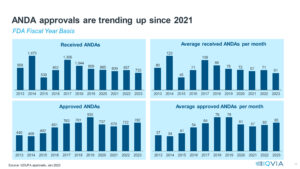Doug Long has become a fixture at AAM meetings, providing invaluable data on the drug industry on behalf of his employer, IQVIA. This presentation is always the highlight of AAM annual meetings. All attendees at this meeting make sure to have their seats nice and early to hear his state of the generic and biosimilars marketplace presentation, which is usually the most attended session at the various AAM meetings, and this year it was no different!
But, before we get into some of the interesting data and trends he discussed, I want to personally congratulate Doug on receiving the highest award that the Association for Accessible Medicines presents, the Lifetime Achievement Award.
Now back to a few of the highlights of some of the trends and stats that Doug shared:
- ADHD medicine use grew 11% over the last five years to over three billion days of therapy in 2022. This demand increase explains in part the shortage of ADHD drugs, especially because there are strict DEA quotas allocated for these drugs, limiting the amount of active pharmaceutical ingredient available for manufacturers.
- Over 500,000 new GLP-1 agonist prescriptions were seen across diabetes and obesity in February 2023, up 152% compared to the prior year, with use rising sharply in the obesity market. Sales of GLP-1 drugs have grown about 70% over the last twelve months and ~84% of the sales are retail.
- Per capita prescription opioid use was down 64% since the peak in 2011. Greater awareness of the opioid crisis along with changes in prescribing habits (significantly lower number of dosage units prescribed per prescription) have contributed to this decrease. But, at the same time, opioid overdose deaths are up 253% since 2011, driven primarily by fentanyl-laced drugs.
- There are ~1,800 fewer pharmacies since December 2020 and more closures are on their way, with CVS planning to close about 900 stores by the end of 2024, the corporate restructuring of Rite Aid impacting pharmacy closures, and other acquisitions and mergers in supermarket chains also likely to further impact closures.
- Drug shortages continue and seem to be more difficult to resolve. We all know the factors that have created many of the drug shortages; for instance, compliance and quality issues, supply chain challenges, and increased demand, all of which contribute to the problem. Shortages of critical drugs, like injectable chemotherapy agents, have caused serious problems for treatment of critically ill patients.
- According to IQVIA, more shortages continue to be reported than resolved, with 58% of shortages ongoing for more than two years.
- Some ANDA trends are reported in the following charts:

While I would like to report on all of the data that Doug provided in his presentation, I would be writing for at least another hour. The one question I have is, who will carry Doug’s banner after he decides to retire? You should be sure to see him in person before he does. It’s a real treat!



